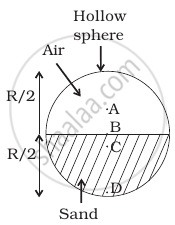Advertisements
Advertisements
Question
If all the particle of a system lie in a cube, is it necessary that the centre of mass be in the cube?
Solution
Yes. As a cube is a 3-dimensional body, all the particles of a system lying in a cube lie in the x,y and z plane.
Let the ith element of mass ∆mi is located at the point (xi,yi,zi).
The co-ordinates of the centre of mass are given as:
\[X = \frac{1}{M} \sum\nolimits_{i = 1}^{i = n} \left( ∆ m_i \right) x_i \]
\[Y = \frac{1}{M} \sum\nolimits_{i = 1}^{i = n} \left( ∆ m_i \right) y_i \]
\[Z = \frac{1}{M} \sum\nolimits_{i = 1}^{i = n} \left( ∆ m_i \right) z_i\]
X, Y and Z lie inside the cube because it is a weighted mean.
APPEARS IN
RELATED QUESTIONS
A child sits stationary at one end of a long trolley moving uniformly with a speed V on a smooth horizontal floor. If the child gets up and runs about on the trolley in any manner, what is the speed of the CM of the (trolley + child) system?
You are holding a cage containing a bird. Do you have to make less effort if the bird flies from its position in the cage and manages to stay in the middle without touching the walls of the cage? Does it makes a difference whether the cage is completely closed or it has rods to let air pass?
Consider the following the equations
(A) \[\vec{R} = \frac{1}{M} \sum_i m_i \vec{r_i}\] and
(B) \[\vec{a}_{CM} = \frac{\vec{F}}{M}\]
In a noninertial frame
Consider the following two statements:
(A) Linear momentum of the system remains constant.
(B) Centre of mass of the system remains at rest.
A ball kept in a closed box moves in the box making collisions with the walls. The box is kept on a smooth surface. The velocity of the centre of mass
In an elastic collision
The structure of a water molecule is shown in figure. Find the distance of the centre of mass of the molecule from the centre of the oxygen atom.

Seven homogeneous bricks, each of length L, are arranged as shown in figure. Each brick is displaced with respect to the one in contact by L/10. Find the x-coordinate fo the centre of mass relative to the origin shown.
Calculate the velocity of the centre of mass of the system of particles shown in figure.

Two persons each of mass m are standing at the two extremes of a railroad car of mass M resting on a smooth track(In the following figure). The person on left jumps to the left with a horizontal speed u with respect to the state of the car before the jump. Thereafter, the other person jumps to the right, again with the same horizontal speed u with respect to the state of the car before his jump. Find the velocity of the car after both the persons have jumped off.

Consider the situation of the previous problem. Suppose each of the blocks is pulled by a constant force F instead of any impulse. Find the maximum elongation that the spring will suffer and the distance moved by the two blocks in the process.
The centre of mass of a system of particles does not depend upon, ______
Define centre of mass.
The centre of mass of a system of two particles divides the distance between them ______.
Which of the following has maximum momentum?
A bullet of mass 20 gram is fired from a gun of mass 2.5 kg with a speed of 750 m/s. The magnitude of recoil velocity of the gun is ______.
For which of the following does the centre of mass lie outside the body?
Which of the following points is the likely position of the centre of mass of the system shown in figure?

